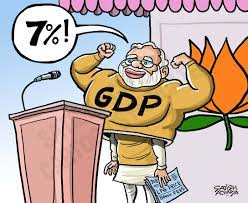For decades, the various governments of both the state and centre have been at war against the other pointing out the GDP growth being less or more during the respective regimes according to the whims and needs of that particular political agenda. The states whether in opposition or not, claim to be a huge contributor towards the GDP and the center seems to glorify itself as the 'Messiah' of the country's economy by making it the fastest growing economy in the world. The honorable finance minister Mrs. Nirmala Sitharaman in her parliament speeches have spectacularly mentioned about the country's growing GDP rates and have praised the Prime Minister and his 'vision' to be not one, but many steps ahead of what the UPA could have ever achieved. In a reply to the same, the former finance minister Mr. P. Chidambaram countered these claims by stating that the growth was in fact higher during the UPA rule. Thus began constant to and fro debates on which regime has brought forward the highest GDP growth and the minions of these formidable rivals started to wage war against one another. Unfortunately no one seems to be analyzing on the actual problem while battling for the eradication of poverty but instead, they focus on the GDP figures to either hide or divert from the actual issues. But in reality, the issue is not about India's GDP.
Ever since Narendra Modi took charge as the Prime Minister of India, the real GDP growth of the country has increased by 5.3% (annualized). This growth was applauded by many including the IMF through its reports. Yet, there arises a question of why are the citizens of the world's largest democracy still struggling in the deep pits of poverty. The issue at hand is not a fluctuating GDP number, rather it is the job potential. While India's GDP grew at a rate of 5.3% as mentioned above, what also grew along with it, is the demand for minimum paying jobs under the Mahatma Gandhi National Rural Employment Guarantee Act (MGNREGA). There was an exponential growth of 5.4% under the scheme which poses to the ultimate question of why are people demanding for the least paying jobs in a fast growing economy. To put in simple words, in the fastest growing economy of the world, people were actually claiming for jobs that pay the bare minimum or lesser. This in itself, is a big dissonance between GDP growth and its translation into actual jobs and therefore, on the income of people as well. In reality, for an economy to flourish, the mere stargazing on the big GDP numbers aren't sufficient. The people should also have an increase in their purchasing power and that shall be the true indication of a growing economy and not the highlighted GDP figures.
Further to note, that the jobs which are created as a result of the growing economy, though less in numbers when compared to its actual potential, tend to exacerbate the social issues prevailing within India. Almost 80% of workers under the MNREGA scheme belong to the oppressed classes such as Dalits, tribals and other backward castes. Meanwhile people from the 'higher' castes constitute almost three quarters of the high paying and demanding jobs that are created with the increase in GDP.
From 1980 to 1990, every percentage of GDP increase in India created an approximate of 2 lakh jobs in the formal sector. In the decade that followed this ratio diminished to just 1 lakh and as time further went on, the RBI even stopped the publication of such data. This is therefore a clear indication of the fact that the quality of the GDP growth is absolutely poor. Thus, it is important to chase the actual incentives of the GDP growth rather than mere excuses to fill the enlarged headlines. While India is proudly saying that there are enough and more manufacturing companies investing and starting their operations in India, it is true that the GDP would grow but the it does not ensure the growth of job potential. For instance, to facilitate the production of the semi conductor chips in India, there were immense amounts of taxpayers' money that was spent to lure in foreign investors. While this does have a strong impact on diplomacy, there is close to zero economic rationale behind this. The process of producing such chips are mainly automated and therefore, there is less labor force that are required for this and thus, the whole screams about such investment creating jobs are nothing but a mere bogus claim when the actual numbers of the people benefitting are considered.
It is true that these numbers projected largely in the headlines project a good image for India on a global frontier, but unfortunately it doesn't change the lives for millions of Indians whose lives were actually supposed to be better through such a growth. Therefore, it is important for those in power to end their quest for large GDP numbers to fill headlines if it does not aid the citizens of the country. As the finance minister has now called for a workshop that aims on further increasing the GDP, perhaps the key focus should be on neutralizing the unequal distribution of wealth and should also focus on the GDP creating a demand and supply for more high paying jobs rather than minimum wages. The growth of GDP and demand for jobs through MNREGA should be inversely proportional. The next time a miraculous GDP figure is displayed in bold, the question of where are the jobs must be raised rather than what's the growth percentage.
*All images are owned by respective creators. The author of this blog claims no ownership of the images in this article



Comments
Post a Comment